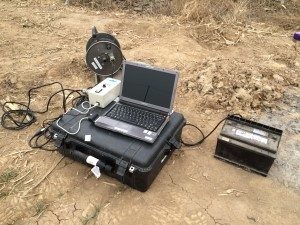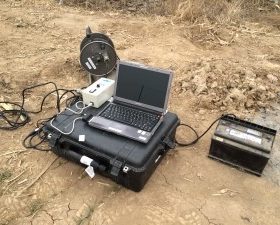
Abs: Quantifying and characterizing groundwater flow in fracture flow systems is a difficult task due to the complexity of these systems. The recently developed colloidal borescope is a useful instrument that can provide direct measurements of flow velocity and direction from wells completed in fractures. Results from the field investigation using the colloidal borescope showed that groundwater flow directions in the unfractured zones agreed with the regional groundwater flow directions. In fractured zones, groundwater flow directions were in a direction corresponding to fracture trends that were different than the inferred potentiometric surface. Groundwater velocities in the fractures were an order of magnitude higher than velocities observed in the unfractured flow zones. The resultant flow direction of the unfractured and fractured flow zones agreed with the observed flow direction of a groundwater hydrocarbon plume.
Testing Overview:
Fractured groundwater system has the characteristics of complex flow path, and the determination of pollutant migration path in fracture zone is a complicated process. Traditionally, the method of determining the velocity and flow of groundwater is to build multiple groundwater monitoring wells in the aquifer and obtain the hydraulic gradient through the measurement of water level data. However, this method is not reliable in the fractured groundwater system. Well installation cost more resources. The hydraulic conductivity coefficient obtained by pumping test in the fractured water of the formation is also proved to be difficult and the reliability is low. Some scientists have conducted a tracer test to verify that the flow of groundwater path in the facture is parallel to the fracture orientation, but due to the presence of porous media around the fissures and the intersection between fissures, the characteristics of groundwater flow are more complex, so a more direct approach is needed to investigate the fracture flow.
Although the tracer method can reliably determine the fissure flow, but the tracer test last longer, incurring more cost, involving greater complexity. So some researchers prefer to conducting the pumping test. This article mainly introduces the analysis of the characteristics of fracturing flow in the groundwater bedrock using the groundwater flow & velocity measurement device – Colloidal Borescope. The study area is located near the Xiangxi River valley near the town of Yichang in Yichang City, Hubei Province. It is located in the middle and lower reaches of the Xiangxi River, and the steep slope of the two sides is characterized by purple sand shale, mudstone and Limestone composition. The depth of study interval ranges from 6 to 60 meters across the surface at 6 different depth location. The water table depth in the monitoring wells is 20 meters below grade.
Colloidal Borescope:
The Colloidal Borescope measures groundwater velocity, direction and particle size in real-time. It accomplishes these difficult tasks by using proprietary hardware and AquaLITE software. The Colloidal Borescope System accurately determines groundwater velocity, flow direction and particle sizes at depth-specific intervals. The Colloidal Borescope System yields thousands of data points per minute for hours of statistically assured data.
Testing Procedure:
Testing depth:
In the groundwater monitoring area, a monitoring well is chosen to deploy the instrument slowly down into the well to the depth where main fracture flow may exist. The targeted depth was selected according to observation of physical characteristics of the core samples recovered during the drilling process. Borescope is lowered to 6 different depths, 59 meters, 57 meters, 54 meters, 52 meters, 44 meters and 36 meters respectively.
Procedure:
After Borescope reached the designated depth, wait for 5 minutes or more so that the groundwater could restore the steady state (to avoid resuspension of larger particles) and then start measuring. After the groundwater is restored, turn on the switch and start tracking the particles in the groundwater stream. Keep the instrument running for at least 15 minutes, stop the run when the data points in the screen stabilize, and record the stored data. Move the probe to the next depth area. If the instrument continues to run for 30 minutes still can not get a stable and regular data trend, then stop the measurement of the depth of the position, the probe need to be moved to the next depth.
Measurement results:
Result Summary:
By using the Borescope to investigate the fracture zone in the borehole, it showed that four location of depth have same characteristics resembling to the fracture zone flow. It can be determined from measurement that the four depth indicates main fracture in the area and serves as preferential flow path. If groundwater contaminants are found in the monitoring area, the four depth of fracture zone may be potential pollutant transport paths. Through the measurement of groundwater flow speed at the four depth, flow rate of pollutant plume can also be determined as well as the impact of pollutants.
